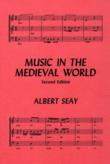Guido d'Arezzo
Period: Medieval
Born: c. 0991 in Arezzo, Italy
Died: c. 1050 in Avellano, France
Nation of Origin: France/Italy
Major Works:
Micrologus de disciplina artis musicae (a theoretical work describing the music of Guido's time) (1025)
Other Information:
It is likely that Guido was born in or near Arezzo, Italy. He served as a Benedictine monk then traveled in 1025 to work for Bishop Theobald in Arezzo, Italy where he lived for some years. Although Guido was not a composer, he is included here because his contributions as an early music theorist made it possible for early composers to begin recording their work in manuscript. Around 1025 Guido created a system of musical notation using a 4-line staff which has evolved into the system we use today. The importance of this work is enormous. Before Guido's invention of musical notation, every singer had to memorize the entire chant repertoire. Those singers then went on to teach the next generation. Small errors in memory or differences of taste caused the chants to change over the years and no two singers would learn a chant precisely the same way. Notation made it possible to record a chant in a definitive form for posterity and easier communication. Guido's last recorded activity is in 1033. His actual death date is unknown.
Guido also created the system of solmisation using the syllables ut, re, mi, fa, sol, and la. The six syllables were derived from the first syllables of each of the first six phrases of the text of a hymn to St. John the Baptist ("Ut queant laxis", "Resonare fibris", "Mira gestorum", "Famuli tuorum", "Solve polluti", and "Labii reatum"). The first phrase of the hymn begins on c and each of the other phrases begins one scale degree higher than its predecessor. The syllable "ut" is still used in France but "do" is used almost everywhere else. Guido discovered that using syllables to teach chants made it possible for his singers to learn new chants more quickly. A popular teaching method arose to teach the syllables by pointing to sections of his hand. The "Guidonian Hand" has been immortalized in numerous illustrations and was used widely as a teaching tool but there is no direct evidence that Guido created this particular mnemonic device. Nonetheless, Guido's innovative teaching methods garnered attention from the Papacy in Rome where he gave a demonstration of his teaching techniques to Pope John XIX in 1028.
Composer Bibliography:
Apel, Willi, The Notation of Polyphonic Music 900-1600, 5th ed., Mediaeval Academy of America, 1961, ASIN: 0910956154
General Bibliography:
Reese, Gustave, Music in the Middle Ages : With an Introduction on the Music of Ancient Times, W.W. Norton & Company, October 1940, ISBN: 0393097501
Sachs, Curt, The Rise of Music in the Ancient World, W. W. Norton & Company, 1943, ASIN: 0393097188
Seay, Albert, Music in the Medieval World, W. W. Norton & Company, 1943, ASIN: 0393097188
Slonimsky, Nicolas and Kuhn, Laura; Editors, Baker's Biographical Dictionary of Musicians, Gale Group, December 2000, ISBN: 0028655257
Sadie, Stanley and Tyrrell, John; Editors, The New Grove Dictionary of Music and Musicians, Groves Dictionaries, Inc., January 2004, ISBN: 0195170679
Rutherford-Johnson, Tim, Kennedy, Michael, and Kennedy, Joyce The Oxford Dictionary of Music, Oxford University Press, 6th Edition, 2012, ISBN: 0199578109
Links to essays at other sites:
Please note: Each link will open in a new window.
Biographical essay from Wikipedia
